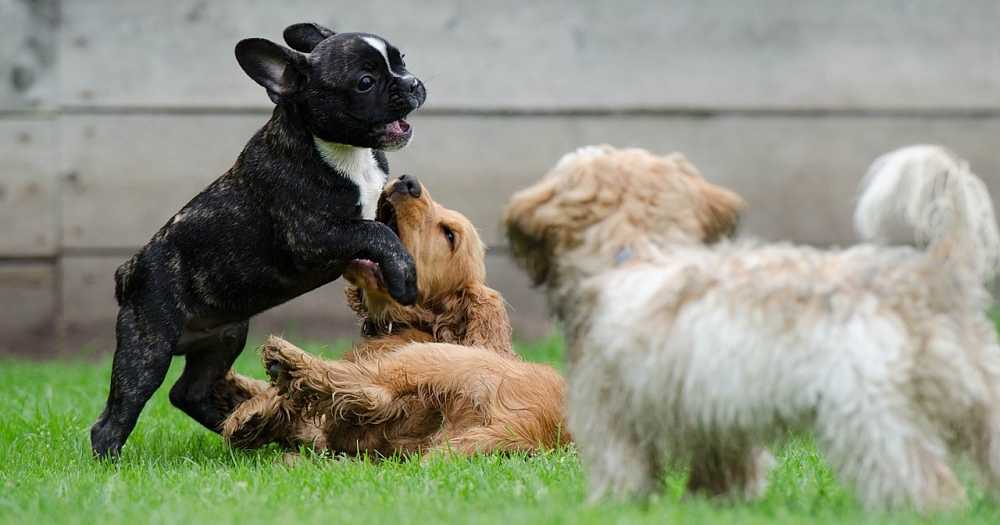A good understanding of dog behavior will help you to understand why your dog does what he does, and help to build a better bond between you.
With that in mind, this article will take a look at dog behavior and the motivations behind it.

Dog behavior and motivations
The domestic dog is a direct descendant of the wolf. Wolves evolved into co-operative pack hunters a long time ago.
Their bodies and brains, senses and abilities changed to serve this purpose. They developed behaviors which helped them thrive in a challenging environment.
These same behaviors and motivations can still be seen today in the domestic dog.
Pack mentality
As pack animals, dogs submit to the pack leader. If you own a dog, this should be you! Dogs are at their most comfortable when they know their place within the pack.
Your dog can get stressed if you give it mixed signals. An example is when you sometimes put up with dominant behavior from them and then sometimes don’t.
Dog body language
Dogs communicate using body language. They use their tails, ears, body posture, eye contact and facial expression. For example, if your dog droops its head and tail when you tell it off, they’re showing submission.
Territorial aggressiveness
It’s natural for dogs to protect what they see as their territory. This doesn’t just mean the house. It can include food, favorite toys, and in extreme cases, even their owner or other human members of their pack.
Socialization
The way wolf packs cement relationships and hone hunting skills is through socialization. That’s why it’s so important you play with your dog.
Wolf packs also bond through hunting together and patrolling their territory. When you take your dog for a walk you’re simulating this. So again walks are an important part of your relationship with your dog.
Chasing things
Wolves have a natural instinct to chase anything that moves. This is because they see it as potential prey. Dog’s also show this instinct. This is why they chase cats and passing cyclists.
Running away
Given the choice of fight or flight most wild animals choose flight. Dogs are no different.
This is especially true when they hear loud, unknown noises like fireworks or thunder. Their natural instinct is to run away.
Vocalization
Wolves have a more limited vocabulary than dogs. They still rely on howling or growling to communicate though. Your dog’s vocabulary also includes barking and whining. They use this to express happiness, fear, anxiety, or to sound a warning.
Quick reference guide to dog behavior
Below is a quick reference guide to dog behavior and how to recognize each type of behavior.
| Behavior Type | Behavior |
|---|---|
| Aggressive | Ears forward or back, close to head. Eyes narrow or staring challengingly. Lips open, drawn back to expose teeth bared in a snarl. Possible jaw snapping. Body tense and upright. Hackles on neck up. Completely dominant position. Tail straight out from body, fluffed up. Snarling, growling, loud barking. |
| Before flight | Ears back. Eyes wide open. Often rolled back and the whites of the eyes showing. Mouth slightly open. Possible drooling. Body shivering and tense, low down and ready to run. Tail held low or between legs. Sometimes yelping or whining, but often no noises. |
| Friendly | Ears back. Eyes wide open, with an alert look. Relaxed, possibly slightly open, "smiling" mouth. Normal posture. Still, or possible wiggling of whole rear end. Tail up and out from the body, and wagging. Whimpering, yapping, or short, high-pitched barking. |
| Guarding | Ears perked up and forward. Eyes wide open and alert. Mouth slightly open, teeth bared. Snapping or gnashing of teeth. Body rigid and tense. Hackles up. Standing very tall in an aggressive or dominant stance. Tail Rigid and held straight out from body. Sometimes fluffed. Loud alert barking. Growling. Snarling. |
| Playful | Ears perked-up and forward, or relaxed. Eyes wide open and sparkly/merry-looking. Mouth relaxed and slightly open, teeth covered. Excited panting. Body relaxed, or front end lowered, rear end up in the air, wiggling in a play-bow. Excited bouncing and jumping up and down. Circling around and running forward and back in an invitation toplay. Tail wagging vigorously. Excited barking. Soft play-growling. |
| Predatory | Ears alert and held forward or backward to catch sounds. Eyes wide open and staring, focusing. Mouth closed. Body rigid and low to ground, ready to spring forward. Quietly sniffing the air. Tail low and straight. Silent. |
| Submissive | Ears down, flattened against the head. Eyes narrowed to slits or wide open, whites showing. Lips pulled way back from the teeth in a "grin". Nuzzling or licking other animal or person on face. Body lowered to ground, front paw raised. Lying on back, belly up. Possible urine leaking/dribbling. Possible emptying of anal scent glands. Tail down between legs. Silent or low, worried whining. Possible yelping/whimpering in fear. |
